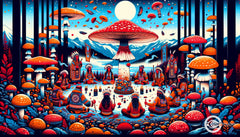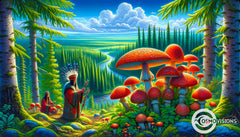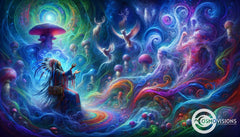The Divine Birth of Ayahuasca: Myths on the Visionary Vine
Posted by Massimiliano Geraci

Among the intricate tapestry of Amazonian mythology resides captivating tales explaining the mythical origins of the psychedelic brew ayahuasca. Known by numerous indigenous ethnic groups across the Upper Amazon Basin, this rich amber elixir has been used in shamanic rituals for centuries to achieve visionary states and divine healing. As venerated as the sacred vine itself are the myths describing ayahuasca’s divine beginnings and arrival to humanity. These creation stories fuse elements of life and death, human and plant, supernatural and natural, into profound parables on the very essence of this revered psychoactive sacrament.
The Myth of the Woman-Yajé
According to the Barasana and other Tukano ethnic groups inhabiting the rainforest borderlands between Colombia and Brazil, the mythological origins of ayahuasca directly relate to the genesis of humankind itself. The first woman's arrival and the sacred vine's birth are depicted as concurrent, intertwined events that transpired during the primordial times when myth and history coalesced.
As the story goes, in ilud tempore when gods and humans freely mingled, the divine Canoe-Anaconda carrying the original man drifted down gushing rivers, depositing their human cargo upon the banks of the Upper Amazon and giving rise to humanity. After the first communal longhouse was constructed, the embryo of ayahuasca made its mythical debut through the remarkable tale of the Woman-Yajé. This primal mother goddess emerged amidst the communal psychedelic celebrations ongoing within the newly built maloca, or longhouse, the quintessential communal structure of Amazonian villages. In the throes of divine birth pangs, the Woman-Yajé entered the uterine-symbolic structure and, amongst the inebriated men, gave birth to her vine-like child, the personified ayahuasca infant.
Unlike a human baby, the newborn vine sprouted anthropomorphic features and was promptly dismembered by the surrounding men, establishing the plant as a sacrificial victim-deity. Each man retrieved a piece of the chopped ayahuasca body to take back to their native villages, where the psychedelic medicine would be cultivated for shamanic purposes. This concluding element, rich with mythic drama, ties together critical themes of blood sacrifice and death logically preceding rebirth in sacred botany. The myth also draws profound symbolic parallels between the snaking, vining botanical growth of ayahuasca and the snake-like umbilical cord, sharing space in the sphere of Amazonian symbology.
On another level, the Woman-Yajé story has been interpreted as symbolic of sacred sexuality and fertility. The Tukano perceive the communal house as the embodiment of both womb and vagina, while the feathers men adorn themselves with in rituals are metaphors for virile fertilization. Therefore, the Woman-Yajé penetrating the uterine longhouse space amongst the assembled and inebriated men equates to a metaphoric sexual act of cosmic proportion. Even the very color of ayahuasca itself, a yellowish hue, holds specific sexual significance for these groups. Hence, through its myth of origin, ayahuasca attains rich and varied layers of symbolism and meaning amongst those for whom it has been culturally interwoven for generations.
The Story of Yube: Mythic Man Turned Celestial Anaconda
Among the Huni Kuin, also identified as Kaxinawá or Cashinahua, the swirls of ayahuasca creation mythology consolidate around the tragic tale of their progenitor Yube. In an idyllic past when animals freely shapeshifted into humans, this ancestral figure embarked on a fateful vision quest that led him to forge intimate relationships between his tribe and the anaconda people residing in an aquatic alternate reality.
In written recordings of this elaborate saga gathered by anthropologists, the human protagonist has been identified interchangeably as Yube, Dua Busen or Yumi, pointing to probable variations across Huni Kuin sub-groups. In a broader context, though, this ancestral hero blends over time with the primordial anaconda figure itself, highlighting the fluid persona concept underpinning Amazonian ontologies.
As the most extensive version recounts, while hunting near a still lagoon one day, Dua Busen observed a tantalizing scene - a tapir emerging from forest cover, coaxing out an alluring anaconda-woman from underwater by tossing genipap fruits into the placid waters. Upon coupling with the willing anaconda-maiden, the tapir returned to Monte. Though married, Dua Busen became consumed with lust for the water goddess himself. By imitating the tapir’s fruit-tossing gestures, Dua Busen also coincided with the anaconda woman, who he then deceitfully courted and agreed to marry in her liquid realm beneath the lagoon.
After squeezing eye-drops sourced from arcane jungle plants into Dua Busen’s eyes to shift his perceptual frequencies, the serpent-bride escorted her new human husband underwater into the bustling anaconda village. Accepted by his supernatural in-laws and accustomed to life amongst the shape-shifting, aquatic folk, Dua Busen stealthily fathered three hybrid children with his anaconda wife. However, deciding one day to defiantly partake in his family’s ceremonial ingestion of ayahuasca, despite his wife’s cautions, Dua Busen found himself gripped with hallucinatory terror and offensively screamed about being attacked by anacondas. This breach of inter-dimensional etiquette triggered the rapid souring of relations with his former allies.
Thanks to the helping interventions of a sympathetic fish-man, Dua Busen escaped alive to human reality. Though after defiantly venturing too close once more to anaconda territory, he was attacked by his fully furious wife and her kin, all seeking violent retribution. Saved barely by his fellow villagers, the battered man disclosed on his death bed the secret to concocting the sacred ayahuasca brew using ingredients that mystically sprouted from his buried corpse - the vine from his arms and legs, the leaves from his eyes. Thus, even when the knowledge of preparatory songs revealed by the expired oracle was temporarily forgotten, apprentice shamans later rediscovered the musical techniques to harmonize with the plant-birth legacy of their martyred ancestor. And this mystical brew continues to provides access to transcendental reality for all who tread the jaguar-strewn paths of shamanism.

Of Severed Digits and Divine Births: Myths on the Roots of Inebriation
Like the multidimensional beings they venerate, Amazonian cosmologies are infused with layer upon layer of symbolic depth. The origin stories told by elders around ritual fires elegantly fuse botanical roots with human limbs, mundane reality with celestial spheres across time and space both physical and metaphysical. These mystically revealed myths lend meaning not just to the plants themselves, but the cultures that have co-evolved together with these remarkable rainforest species over centuries.
The Desana Myth: Of Yajé, Coca and Solar Gifts
Along the kinetically charged Colombian-Brazilian borderlands throttled by the surging Vaupés River resides the Desana tribe, esteemed guardians of mystically revealed insights into humanity’s fleeting folly. Their mythic traditions recount how the use of visionary plants, especially yajé (ayahuasca), emerged from the gestational throes of divine births and sacrificial dismemberments.
In the veil of time immemorial, an intimate relationship based on plant wisdom and reciprocity existed between people and planets - earthly humans and the celestial Father-Sun. Being the first shaman, the Sun used tobacco, hallucinogens and percussive instruments in rituals, establishing behavioral codes and bodily decorations that define Amazonian spirituality. Therefore, what is now considered intrinsic to indigenous identity, like face-painting and sage-like plant reverence, originated directly from this solar benefactor.
However, the myth relates, while wandering the sandy banks of the Vaupés one day the Sun’s daughter, yajé vine sprouting from inside her fecund womb, was seized by birth pangs. A passing Desana woman seeking to assist the struggling maiden grabbed her hand for support, only for the divine daughter to thrash so violently that her helper’s finger broke clean off! Discarding the severed digit, the elder returned home and planted it, thus sprouting the first ayahuasca plant from the buried finger.
Later, the Sun’s second daughter also encountered a Desana woman when giving birth on the same river bank. Again the mortal broke her finger assisting the birthing goddess, which she buried for the coca plant to emerge from this severed piece in turn. Through these poignant, ready metaphors of fleshly fruiting bodies, yajé and coca became consecrated as sacred botanical offspring of the Father-Sun himself bestowed philanthropically unto humanity through divine parturition assisted by Earthly elders. Hence, when modern Desana, People-of-the-Tapir, prepare these visionary sacraments respectfully and consume them ritually, they commune with invisible spirits and mythic traditions linking back to the dawn of their very cosmogony.
The Siona Myth: Lessons on Apprenticeship from Sun and Moon
The Siona tribe resides in the branching rainforest rivers nourished by the milk chocolate hues of the mighty Putumayo and wedged between Ecuador and Colombia. As one of dozens of ethnic groups classifiable linguistically as western-Tukanoan, Siona worldviews hold Sun and Moon not as mere cosmic bodies lighting diurnal skies but as the original shamanic initiates into the mysteries of the obscure jungle brew known as yagé or ayahuasca.
According to their mythology, whilst still embodied earthly beings during mythic phases of reality, Sun and Moon undertook apprenticeship as shamans under the visionary influences of powerful psychoactive plants like yagé. However, while Father-Sun quickly mastered the realms accessed via trance states and easily interpreted the symbols and lessons strewn along this psychic path, his lunar apprentice struggled profoundly with many common initial hurdles.
As the most extensive Siona telling relates, evenings often brought comforting sounds of Sun expanding consciousness, chanting sacred songs (icaros) received from plant spirit doctors, shaking his shamanic rattle, and playing ritual flutes to serenade forces occupying non-ordinary dimensions. Observing such mastery nights on end kindled latent shamanic desire within Moon, who cautiously approached Sun one evening for his first yagé medicine lesson.
Though Moon gulped down excessive portions of bitter tea, the chaotic clarity initially overwhelmed him. Vomiting and evacuation pre-emptedParading wildly about the maloca, deliriously blowing flutes, Moon had activated something within but lacked stable wisdom to harness it properly. Yet Sun compassionately calmed and coached the overwhelmed apprentice in succeeding ceremonies until the latter gathered enough skills to emerge reborn, bragging even of surpassing his venerable mentor. And while Sun and Moon eventually migrated to their stations, illuminating present Earthly existence, the legacy of their mythic initiation has survived to teach modern Siona ritual specialists important tips for guiding ayahuasca apprentices.
Of Spilt Brews and Defiled Tombs: Cautionary Tales on Sacramental Disrespect
Amazonian traditions point to the possible perils of disrespecting sacred substances that conduit to cosmic consciousness. Various myths carry overt cautionary themes regarding the importance of revering ritual protocols, sanctified spaces and plant spirit guardians. Though punishment comes in many forms for the naive or defiant, common conclusions intimate that thoughtless actions can diminish spiritual powers for entire tribes when fundamental principles underlying shamanic plant practices become breached.
Spilling Natem: Transgressions that Trigger Intergenerational Curses
Known for a fierce independence nearly matching the verdant viciousness of their jungle habitats, the Shuar have honed the visionary vine natem into a sophisticated psycho-spiritual technology for traversing layers of reality since time immemorial. However, one oft-repeated myth in their oral chronicles seeks to reinforce codes of conduct when participating in this profound practice.
As the legend states, in eras when natem ceremonies still retained innocence, an elder shaman had prepared a cauldron of pungent psychoactive tea to share amongst villagers for mystical communion that night. However, attracted by percussive sounds signaling the start of festivities, one over-eager yet underage youth prematurely rushed toward the ceremonial hut. In his overly excited state, the uninitiated boy tripped over the boiling vat of brew, spilling the sacramental substance across the earthen maloca floor.
This symbolic act of irreverence unleashed grave consequences - the offended plant spirit cursed humanity in that moment by diminishing natem’s power while augmenting its risks. Ever since, extensive fasting, concentrated silence and ingesting copious amounts of the tea became mandatory to achieve the clarity of visions that the clumsy youth’s transgression had diluted for his people. And with breaches now bringing hallucinatory jeopardy rather than just hilarity, the legend reminds modern souls not take lightly these sacrosanct shamanic symbols passed down over generations nor their fundamental codes for respectful engagement.
The Desecrated Tomb of Sinchihuyacui: Royal Origins of “Vine-of-the-Dead”
While numerous indigenous groups across Peru integrate the psychoactive ayahuasca beverage into elaborate shamanic rituals for healing revelation, the brew holds a royal pedigree tracing to tragic Incan descent. At least according to one recently revealed myth propagated by local curandero (ritual healer) Pablo Amaringo amongst mestizo (mixed-race) populations around Pucallpa where the giant snaking Ucayali River meets Amazon fluvial forces.
The tale describes a mythic Shiri tribe ruled by the glorious warrior-king Sinchihuyacui, whose defeat against rivals left him crestfallen. Seeking solace before a hand-planted grove of trees near his royal garden, the king then died heartbroken on that very spot. Years later in spectral visions, the grieving Queen Gaamacuina was implored by her deceased husband to bring ceremonial objects from Sinchihuyacui’s illustrious reign to his neglected gravesite.
Arriving with hesitation borne of mourning, the royal widow discovered to her astonishment the dazzlingly radiant Sinchihuyacui arise from his tomb, clutching a resplendent golden rod. As the awestruck queen collapsed apoplectically onto soil strewn with royal relics, one of her equally stunned maidens yelled out prophetic chants - including the fated Quechua phrase naming the ayahuasca vine foreshadowing its mythic emergence in this story - “ayaruna”, meaning “vine-of-the-dead”.
For the resurrected king then proclaimed that while sorrowful when living, his spirit now channeled eternal wisdom from parallel realms accessible via the interdimensional ayahuasca brew, which he manifested from his royal mane now sprouting on a nearby tree. And he commanded his Quechua subjects to henceforth prepare this vine with accompanying chacruna foliage sprouting by his buried feet, as means of communicating across cosmic boundaries - all part of the bequest left by their former supreme but surreal monarch. Hence the vine once animating a mournful king now facilitates continuing dialogues between mortal seekers and the spiritual dimensions from whence their sacred plant allies emerge.

The Sacred Substance Beneath the Myth: Honoring Ayahuasca’s Eternal Wisdom
Ayahuasca myths of origin are revelations in themselves. They integrate meaningful explanations for shamanic symbols with mystical metaphors for human life stages, whilst embedding cautionary codes for respectful engagement. Yet running as the common thread across stories is the depiction of ayahuasca as a sentient plant-teacher compassionately communicating through visions across consciousness, dimensions and generations.
Therefore, the magical motifs within these creation stories, echoing through Amazonian jungle canopies for centuries, are sublime reminders that irrespective of mythical plotlines, ayahuasca always resides as the sacred substance beneath the stories themselves. And like the interdimensional realities revealed under this remarkable plant spirit’s influence, its eternal wisdoms extend far beyond rationale barriers or limitations imposed upon this world by cultural constraints.






















